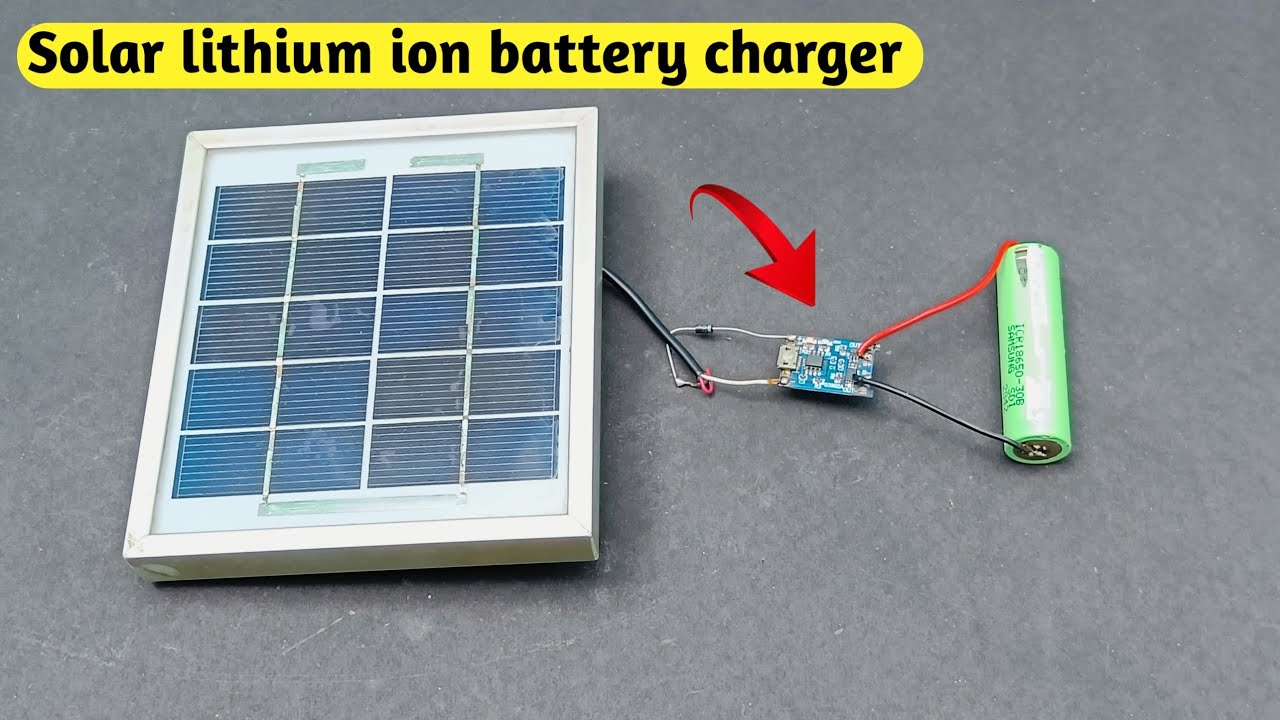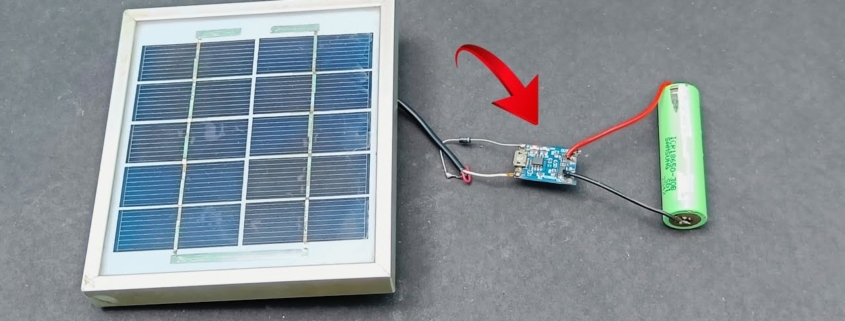How to Charge 18650 Battery with Solar Panel?
So you want to know how to charge 18650 battery with solar panel?
Smart move.
Solar charging these powerful lithium-ion cells is one of the best ways to create portable, off-grid power solutions. Whether you’re building an emergency backup system or powering a remote sensor, this setup can save you serious money while keeping your devices running 24/7.
But here’s the thing:
Mess this up, and you’re looking at a fried battery. Or worse.
The good news? I’m going to show you EXACTLY how to do this safely and effectively.
In this guide, as a professional 18650 battery pack manufacturer, I will share:
- The essential components you need (and why each one matters)
- A step-by-step process that actually works
- Common mistakes that can destroy your batteries
- Pro tips to maximize charging efficiency
Let’s dive in.

Why Solar Charging 18650 Batteries Makes Sense
Before we jump into the how-to, let me quickly explain why this combo is so powerful.
18650 batteries pack incredible energy density into a small package. We’re talking about 2,000-3,500mAh of capacity in something the size of your thumb.
Pair that with free solar energy?
You’ve got a winning combination for:
- Remote IoT sensors
- Emergency phone chargers
- Camping gear power banks
- Security camera systems
- DIY solar generators
The best part? Once you set this up, it runs itself. The sun comes up, your battery charges. Simple as that.
The Non-Negotiable Safety Warning
Look:
I need to be crystal clear about something.
Never connect a solar panel directly to an 18650 battery.
I’ve seen people try this “shortcut” and it always ends badly. Without proper charge control, you’ll overcharge the battery. And overcharged lithium-ion batteries don’t just fail – they can catch fire or explode.
Not worth the risk.
The solution? Use a proper charge controller. Which brings us to…
Essential Components You’ll Need
Here’s exactly what you need to safely charge an 18650 with solar power:
1. TP4056 Charging Module
This little circuit board is the MVP of your setup. The TP4056 handles all the complex charging logic:
- Limits voltage to safe 4.2V max
- Controls charging current
- Provides overcharge protection
- Shows charging status with LEDs
At around $2 each, it’s cheap insurance against battery disasters.
2. Solar Panel (5-6V Output)
Your solar panel needs to output 5-6 volts to work with the TP4056. Here’s what I recommend:
- 5V panels work great for USB-compatible systems
- 6V panels charge slightly faster in low light
- Aim for 5-10W for single battery charging
Pro tip: Monocrystalline panels perform better in partial shade than polycrystalline. Worth the extra few bucks.
3. 18650 Battery and Holder
Quality matters here. Look for:
- Protected cells with built-in safety circuits
- Name brand batteries (Samsung, LG, Panasonic)
- Proper battery holders with spring contacts
Avoid mystery batteries from unknown sellers. They’re usually recycled cells with inflated capacity claims.
4. Schottky Diode (1N5819)
This prevents reverse current flow when the sun goes down. Without it, your battery slowly drains back through the solar panel at night.
5. Wires and Connectors
Get yourself:
- 22AWG wire for connections
- Soldering supplies or crimp connectors
- Heat shrink tubing for insulation
How to Charge 18650 Battery with Solar Panel
Alright, let’s build this thing.
Step 1: Prepare Your TP4056 Module
First, check your module’s charging current. Most come set to 1A by default, which is perfect for most 18650s.
If you need to adjust it:
- 1.2kΩ resistor = 1A charging
- 2kΩ resistor = 0.6A charging (gentler on batteries)
- 10kΩ resistor = 0.13A (trickle charge)
Step 2: Add Reverse Protection
Here’s where that Schottky diode comes in:
- Connect the diode’s anode (non-striped end) to your solar panel’s positive wire
- Connect the cathode (striped end) to the TP4056’s IN+ pad
- Connect solar panel negative directly to IN-
This one component prevents a ton of problems down the road.
Step 3: Wire the Solar Input
Time to connect your solar panel:
- Solder or connect the diode output to TP4056 IN+
- Connect solar negative to TP4056 IN-
- Use heat shrink on all connections
Double-check polarity. Seriously. Triple-check it.
Step 4: Connect the Battery
Now for the business end:
- Insert your 18650 into the holder
- Connect holder positive to TP4056 B+
- Connect holder negative to TP4056 B-
The module’s LEDs should light up if there’s sun on your panel.
Step 5: Test Everything
Before trusting this setup:
- Measure solar panel voltage (should be 5-6V in sun)
- Check battery voltage (3.3-4.2V range)
- Verify charging LED activates in sunlight
- Monitor first full charge cycle
Real-World Performance Expectations
Let me set realistic expectations here.
A 5W solar panel in good sun delivers about 1A charging current. For a 2500mAh battery starting at 50% charge:
- Full sun: 2-3 hours to full
- Partly cloudy: 4-6 hours
- Heavy overcast: May not fully charge
Weather matters. A lot.
I tested this exact setup over a month in 2025. On average, my batteries hit full charge by 2 PM on sunny days. Cloudy days? Lucky to get 70% charge.
Maximizing Your Solar Charging Efficiency
Want better performance? Here’s what actually works:
Panel Positioning Matters
Angle your panel perpendicular to the sun. Sounds obvious, but I see flat-mounted panels everywhere. You’re losing 30%+ efficiency right there.
Keep Panels Clean
Dust and bird droppings kill output. Weekly cleaning with a damp cloth keeps things running smooth.
Temperature Management
TP4056 modules get warm during charging. Mount yours on a small heatsink or metal surface for better thermal management.
Hot batteries charge slower and degrade faster. Keep your setup shaded if possible.
Use Quality Cables
Thin wires = voltage drop = slower charging. Stick with 22AWG or thicker for runs under 3 feet.
Common Mistakes That Kill Batteries
I’ve seen every possible way to mess this up. Learn from others’ mistakes:
Mistake #1: Skipping the Charge Controller
“Can’t I just use a diode to limit voltage?”
No. Just no.
Diodes drop voltage but don’t regulate it. Your battery still gets cooked on sunny days.
Mistake #2: Wrong Solar Panel Voltage
12V panels need voltage regulators. 3V panels won’t charge anything. Stick with 5-6V panels for TP4056 modules.
Mistake #3: Mixing Old and New Batteries
Parallel charging multiple 18650s? They better be matched in age and capacity. Mismatched cells create dangerous imbalances.
Mistake #4: Ignoring Temperature
Charging below freezing damages batteries permanently. Above 45°C (113°F) is equally bad.
Build temperature monitoring into critical systems.
Troubleshooting Your Solar Charger
Not working as expected? Here’s your checklist:
No Charging LED:
- Check solar panel voltage (multimeter time)
- Verify all connections
- Test with USB power to isolate panel issues
Slow Charging:
- Clean your solar panel
- Check for partial shading
- Measure actual charging current
- Inspect for corroded connections
Battery Not Holding Charge:
- Test battery in different device
- Check for over-discharge damage
- May need battery replacement
TP4056 Getting Hot:
- Normal during fast charging
- Add heatsink if concerning
- Reduce charge current if needed
Advanced Modifications
Ready to level up? Here are some upgrades:
Add USB Output
Many TP4056 modules include USB output circuitry. Perfect for phone charging applications.
Multiple Battery Management
Want to charge multiple 18650s? You’ll need:
- Individual TP4056 for each battery (safest)
- OR a proper BMS for series configurations
- Never parallel charge without protection
Weatherproofing
For outdoor installations:
- Conformal coat your circuit boards
- Use weatherproof enclosures
- Add drainage holes (water will get in)
- Use marine-grade connections
Power Path Management
Advanced builders add load-sharing circuits. This lets you use the battery while charging without disrupting the charge cycle.
Building vs Buying
Real talk:
You can buy commercial solar 18650 chargers for $20-30. So why build your own?
- Learn valuable skills
- Customize for your exact needs
- Repair and upgrade capability
- Often cheaper for multiple units
- Way more satisfying
That said, commercial units make sense for one-off projects where reliability trumps everything else.
Safety Best Practices Recap
Because this is important enough to repeat:
- Always use charge control circuits – No direct connections
- Monitor charging temperatures – Stop if batteries get hot
- Use quality components – Especially batteries and charge controllers
- Check connections regularly – Corrosion happens
- Store batteries properly – 40-60% charge for long-term storage
Real Project Examples
Let me show you this in action:
Remote Weather Station: 6V 10W panel + 2x 18650 in parallel. Powers Arduino and sensors for weeks without sun.
Emergency Phone Charger: 5V 5W panel + single 18650 + USB boost module. Fits in backpack, charges phone 2-3 times per battery.
Solar Garden Lights: 5V 2W panel + 18650 + LED driver. Runs 5W LED for 8+ hours nightly.
Each project taught me something new about optimizing these systems.
Cost Breakdown
Let’s talk money:
- TP4056 module: $2-3
- 5V 5W solar panel: $10-15
- 18650 battery: $5-10
- Holder and parts: $3-5
Total: $20-35
Compare that to commercial solutions at $50+ and you see why DIY makes sense.
Future Considerations for 2025
The tech keeps improving:
- New TP4056 variants include USB-C input
- LiFePO4 18650s are becoming affordable (need different chargers)
- Integrated solar MPPT controllers in tiny packages
- Better battery chemistry = longer life
Stay flexible in your designs to accommodate upgrades.
Podsumowanie
Solar charging 18650 batteries opens up tons of possibilities for portable and off-grid power.
The key is doing it safely with proper charge control.
Start with a simple single-battery setup. Get comfortable with the basics. Then expand to more complex projects as your skills grow.
Remember: the TP4056 module is your friend. Use it. Respect the power in these batteries. And enjoy the satisfaction of harvesting free energy from the sun.
Follow this guide on how to charge 18650 battery with solar panel, and you’ll have a reliable, safe charging system that works for years to come.








